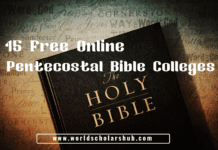There are several translations of the Bible in different languages since the Bible was originally written in Greek, Hebrew, and Aramaic. So, there are a lot of translations to pick from. Before you select a Bible translation, you need to know the Bible translations to avoid.
Yes, you read that right. There are certain translations of the Bible you should avoid reading. You should avoid reading altered versions of the Bible.
The Bible contradicts some beliefs, so people alter God’s words to fit in their beliefs. If you don’t belong to the religious groups that have different beliefs, then you should avoid reading some Bible translations.
Below are the top 5 Bible translations to avoid.
Table of Contents
5 Bible Translations to Avoid
Here, we will be discussing each one of the top 5 Bible translations to avoid.
We will also provide you with the major differences between these Bible translations and other widely accepted Bible translations.
The Bible translations will also be compared with some accurate Bible translations; New American Standard Bible (NASB) and King James Versions (KJV).
1. New World Translation (NWT)
New World Translation is a translation of the Bible published by the Watchtower Bible and Tract Society (WBTS). This Bible translation is used and distributed by Jehovah’s witnesses.
The New World Translation was developed by the New World Bible Translation Committee which was created in 1947.
In 1950, WBTS published its English version of the New Testament as The New World Translation of the Christian Greek Scriptures. WBTS released translations of various Old Testament as the New World Translation of the Hebrew Scripture from 1953.
In 1961, the Watchtower Bible and Tract Society started publishing the NWT in other languages. WBTS released the complete version of the New World Translation Bible in 1961.
During the launch of the NWT Bible, WBTS stated that the New World Translation Committee requested that its members remain anonymous. So nobody knows whether the members of the committee have enough qualifications needed to translate a Bible.
However, it was later revealed that four of the five disclosed translators don’t have the right qualifications to translate the Bible; they don’t know of any of the Bible languages: Hebrew, Greek, and Aramaic. Only one of the translators know the Bible languages needed to attempt Bible translation.
However, WBTS claimed that the NWT Holy Scripture was translated directly from Hebrew, Aramaic, and Greek into modern-day English by a committee of anointed witnesses of the Jehovah.
Before, the release of NWT, Jehovah’s Witnesses in English-speaking countries primarily used the King James Version (KJV). WBTS decided to publish its own version of the Bible because most of the Bible versions were translated into old languages.
Major differences between NWT and other accurate Bible translations
- A lot of verses are missing in this Bible translation and new verses were also added.
- Has different wording, NWT translated Greek words for Lord (Kurios) and God (Theos) as “Jehovah”
- Does not identify Jesus as a holy deity and part of the Trinity.
- Inconsistent translation technique
- Refer to the ‘New Testament’ as the Christian Greek Scripture, and the ‘Old Testament’ as the Hebrew Scripture.
New World Translation Compared with Accurate Bible Translations
NWT: In the beginning, God created the heavens and the earth. Now the earth was formless and desolate, and there was darkness upon the surface of the watery deep, and God’s active force was moving about over the surface of the water. (Genesis 1:1-3)
NASB: In the beginning God create the heavens and the earth. And earth was a formless and desolate emptiness, and darkness was over the surface of the deep, and the spirit of God was hovering over the surface of the waters. Then God said, “Let there be light”; and there was light. (Genesis 1:1-3)
KJV: In the beginning God created the heaven and the earth. And the earth was without form and void, and darkness was upon the face of the deep. And the Spirit of God moved upon the face of the waters. And God said, Let there be light: and there was light. (Genesis 1:1-3)
2. The Clear Word Bible Translation
The Clear Word is another Bible translation you should avoid. It was originally published in March 1994 as the Clear Word Bible.
The Clear Word was single-handedly translated by Jack Blanco, former Dean of the School of Religion at Southern Adventist University.
Blanco originally wrote TCW as a devotional exercise for himself. He was later encouraged by his friends and family to publish it.
The release of the Clear Word Bible brought a lot of controversies, so Jack Blanco decided to replace the word “Bible” with “expanded paraphrase”. John Blanco claimed that The Clear Word is not a translation of the Bible but “an expanded paraphrase to build strong faith and nurture spiritual growth”.
A lot of people use TCW as a Bible and not as a devotional paraphrase. And this is wrong. TCW is 100% paraphrased, a lot of God’s words have been interpreted in the wrong way.
The Clear Word was initially printed by the Southern College Press of Southern Adventist University and sold in Church-owned Adventist Book Centers.
This version of the Bible is commonly used in the Seventh-day Adventist Church. Even though, The Clear Word is not yet officially endorsed by the Seventh-day Adventist Church.
Major differences between The Clear Word and other Bible translations
- Unlike other paraphrases, TCW is written in a verse-by-verse format instead of paragraphs
- Misinterpretation of some words, “Lord’s Day” was replaced with “Sabbath”
- Added Seventh-day Adventist Church doctrines
- Missing verses
The Clear Word Translation Comparison with Accurate Bible Translations
TCW: This earth began by an act of God. He created the heavens and the earth. The earth was only a mass of created matter floating in space, covered with a vapor garment. Everything was dark. Then the Holy Spirit hovered over the vapor, and God said, “Let there be light.” And everything was bathed in Light. (Genesis 1:1-3)
NASB: In the beginning God create the heavens and the earth. And earth was a formless and desolate emptiness, and darkness was over the surface of the deep, and the spirit of God was hovering over the surface of the waters. Then God said, “Let there be light”; and there was light. (Genesis 1:1-3)
KJV: In the beginning God created the heaven and the earth. And the earth was without form and void, and darkness was upon the face of the deep. And the Spirit of God moved upon the face of the waters. And God said, Let there be light: and there was light. (Genesis 1:1-3)
3. The Passion Translation (TPT)
The Passion Translation is among the Bible translations to avoid. TPT was published by Broadstreet Publishing Group.
Dr. Brian Simmons, the lead translator of The Passion Translation, described TPT as a modern, easy-to-read Bible translation that unlocks the passion of God’s heart and expresses his fiery love-merging emotion and life-changing truth.
TPT is actually entirely different from his description, this Bible translation is so different from other Bible translations. In fact, TPT doesn’t qualify to be called a translation of the Bible rather it’s a paraphrase of the Bible.
Dr. Simmons interpreted the Bible in his own words instead of translating the Bible. According to Simmons, TPT was developed from original Greek, Hebrew, and Aramaic texts.
Currently, TPT has only the New Testament, along with Psalms, Proverbs, and Song of Songs. Blanco also published The Passion Translation of Genesis, Isaiah, and Harmony of Gospels separately.
In early 2022, Bible Gateway removed TPT from its site. Bible Gateway is a Christian website designed to provide Bible in different versions and translations.
Major differences between The Passion Translation and other Bible translations
- Derived based on essential equivalence translation
- Includes additions that are not found in the source manuscripts
Passion Translation Compared with Accurate Bible Translations
TPT: When God created the heavens and the earth, the earth was completely formless and empty, with nothing but darkness draped over the deep.
God’s Spirit swept over the face of the waters. And the God announced: “Let there be light,” and light burst forth! (Genesis 1:1-3)
NASB: In the beginning God create the heavens and the earth. And earth was a formless and desolate emptiness, and darkness was over the surface of the deep, and the spirit of God was hovering over the surface of the waters.
Then God said, “Let there be light”; and there was light. (Genesis 1:1-3)
KJV: In the beginning God created the heaven and the earth. And the earth was without form, and void; and darkness was upon the face of the deep.
And the Spirit of God moved upon the face of the waters. And God said, Let there be light: and there was light. (Genesis 1:1-3)
4. The Living Bible (TLB)
The Living Bible is a paraphrase of the Bible translated by Kenneth N. Taylor, the founder of Tyndale House Publishers.
Kenneth N. Taylor was motivated to create this paraphrase by his children. Taylor’s children had difficulties understanding the old language of the KJV.
However, Taylor misinterpreted a lot of verses in the Bible and also added his own words. Original Bible texts were not consulted and TLB was based on the American Standard Version.
The Living Bible was originally published in 1971. In the late 1980s, Taylor and his colleagues at Tyndale House Publishers invited a team of 90 Greek and Hebrew Scholars to revise The Living Bible.
This project later led to the creation of an entirely new translation of the Bible. The new translation was published in 1996 as the Holy Bible: New Living Translation (NLT)
NLT is actually more accurate than TLB because NLT was translated based on dynamic equivalence (thought-for-thought translation).
Major differences between TLB and other Bible translations:
- Was not developed from the original manuscripts
- Misinterpretation of verses and passages in the Bible.
The Living Bible Compared with Accurate Bible Translations
TLB: When God began creating the heavens and the earth, the earth was a shapeless, chaotic mass, with the Spirit of God brooding over the dark vapors. Then God said, “Let there be light” and light appeared. (Genesis 1:1-3)
NASB: In the beginning God create the heavens and the earth. And earth was a formless and desolate emptiness, and darkness was over the surface of the deep, and the spirit of God was hovering over the surface of the waters. Then God said, “Let there be light”; and there was light. (Genesis 1:1-3)
KJV: In the beginning God created the heaven and the earth. And the earth was without form, and void; and darkness was upon the face of the deep. And the Spirit of God moved upon the face of the waters. And God said, Let there be light: and there was light. (Genesis 1:1-3)
5. The Message (MSG)
The Message is another paraphrase of the Bible that you should avoid. MSG was translated by Eugene H. Peterson in segments between 1993 to 2002.
Eugene H. Peterson completely changed the meaning of the scriptures. He added a lot of his words to the Bible and removed some of God’s words.
However, the publisher of MSG claimed that Peterson’s work has been thoroughly received by a team of recognized Old and New Testament Scholars to ensure that it is accurate and faithful to the original languages. This description is not true because MSG contains a lot of errors and false doctrines, it’s not faithful to God’s words.
Major differences between MSG and Other Bible translations
- It is a highly idiomatic translation
- The original version was written like a novel, the verses are not numbered.
- Misinterpretation of verses
The Message Compared with Accurate Bible Translations
MSG: First this: God created the Heavens and Earth – all you see, all you don’t see. Earth was a soup of nothingness, a bottomless emptiness, an inky blackness. God’s Spirit brooded like a bird above the watery abyss. God spoke: “Light!” And light appeared. God saw that light was good and separated light from dark. (Genesis 1:1-3)
NASB: In the beginning God create the heavens and the earth. And earth was a formless and desolate emptiness, and darkness was over the surface of the deep, and the spirit of God was hovering over the surface of the waters. Then God said, “Let there be light”; and there was light. (Genesis 1:1-3)
KJV: In the beginning God created the heaven and the earth. And the earth was without form, and void; and darkness was upon the face of the deep. And the Spirit of God moved upon the face of the waters. And God said, Let there be light: and there was light. (Genesis 1:1-3).
Frequently Asked Questions
What is a Paraphrase?
Paraphrases are Bible versions written to be easier to read and understand. They are the least accurate among the translations of the Bible.
What is the easiest and most accurate Bible to read?
New Living Translation (NLT) is one of the easiest Bible translation to read and it's also accurate. It was translated using thought-for-thought translation.
Which Bible version is more accurate?
New American Standard Bible (NASB) is widely considered to be the most accurate translation of the Bible in english language.
Why are there Altered Versions of the Bible?
The Bible is altered by certain groups to fit in with their beliefs. These groups include their beliefs and doctrines to the Bible. Religious groups like Jehovah's witnesses, Seventh Day Adventists and Mormons have altered the Bible severally.
We also Recommend:
- Bible quiz questions and answers PDFs
- 25 Best Free Theology Degree Online
- Free Online Bible Study Courses with Certificates
- 30 Funny Bible Jokes that will crack you up.
Conclusion
As a Christian, you should not read any translation of the Bible because certain groups like the Jehovah’s Witnesses have altered the Bible to fit in their beliefs.
It’s advisable to avoid reading paraphrases. Paraphrase gives priority to readability, this leaves room for a lot of errors. Bible paraphrases are not translations but interpretations of the Bible in the translator’s words.
Also, you need to avoid translations that were developed by a single person. The translation is tedious work and it’s impossible for a person to translate the Bible perfectly.
You can check out the list of the top 15 most accurate Bible translations according to Scholars to learn more about different Bible translations and their level of accuracy.
We have now come to the end of this article on the top 5 Bible translations to avoid, we hope this article was helpful. Let us know your thoughts in the Comment Section.



